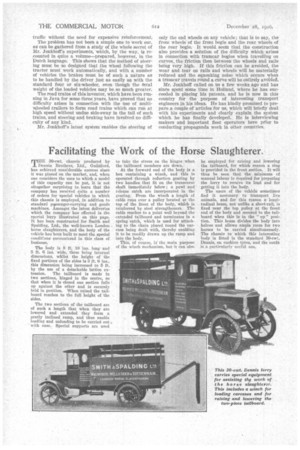Facilitating the Work of the Horse Slaughterer.
Page 56

If you've noticed an error in this article please click here to report it so we can fix it.
MITE 30-ewt. chassis produced by _IL Dennis Brothers, Ltd., Guildford, has achieved considerable success since it was placed on the market, and, when one considers the uses to which a model of this capacity can be put, it is not altogether surprising to, learn that the company has received Quite a number of orders for special vehicles in which this chassis is employed, in addition to standard passenger-carrying and goods machines. Amongst the latest deliveries which the company has effected is the special lorry illustrated on this page. It has been constructed for Smith and Spalding, Ltd., the well-known London horse slaughterers, and the body of the vehicle has been built to meet the special conditions encountered in this class of business.
The body is 8 ft. 10 ins, long and 5 ft. 6 ins, wide, these being internal dimensions, whilst the height of the fixed portions of the sides is 3 ft. 6 ins„ this dimension being increased to 5 ft. by the use of a detachable lattice extension. The tailboard is made in two sections, hinged in the centre, so that when it is closed one section falls up against the other and is securely held in position. When raised the tailboard reaches to the full height of the sides.
The two sections of the tailboard are of such a length that when they are lowered and extended they form a gently inclined ramp, and thus enable loading and unloading to be carried out with ease. Special supports are used to take the stress on the hinges when the tailboard members are down.
At the forward end of the body is a box containing a winch, and this is operated through reduction gearing by two handles. that fit OD the transverse shaft immediately below ; a pawl and release catch are incorporated in the gearing. From the winch a length of cable runs over a pulley located at the top of the front of the body, which is reinforced by steel strengtheners. The cable reaches to a point well beyond the extended tailboard and terminates in a spring catch, which is used for attaching to the chain placed round the carcase being dealt with, thereby enabling it to be readily drawn up the ramp and into the body.
This, of course, is the main purpose of the winch mechanism, but it can aim be employed for raising and lowering the tailboard, for which reason a ring is provided in the front section. It will thus be seen that the minimum of manual labour is required for preparing the lorry to receive its load and for getting it into the body.
The users of the vehicle sometimes find it necessary to transport live animals, and for this reason a longitudinal beam, not unlike a sheet-rail, is fixed near the top pulley at the front end of the body and secured to the tailboard when this is in the "up" position. This beam divides the body into halves and allows ample room for two horses to be carried simultaneously. The chassis to which this interesting body is fitted is the standard 30-cwt. Dennis, on cushion tyres, and the outfit is a particularly useful one.




































































































